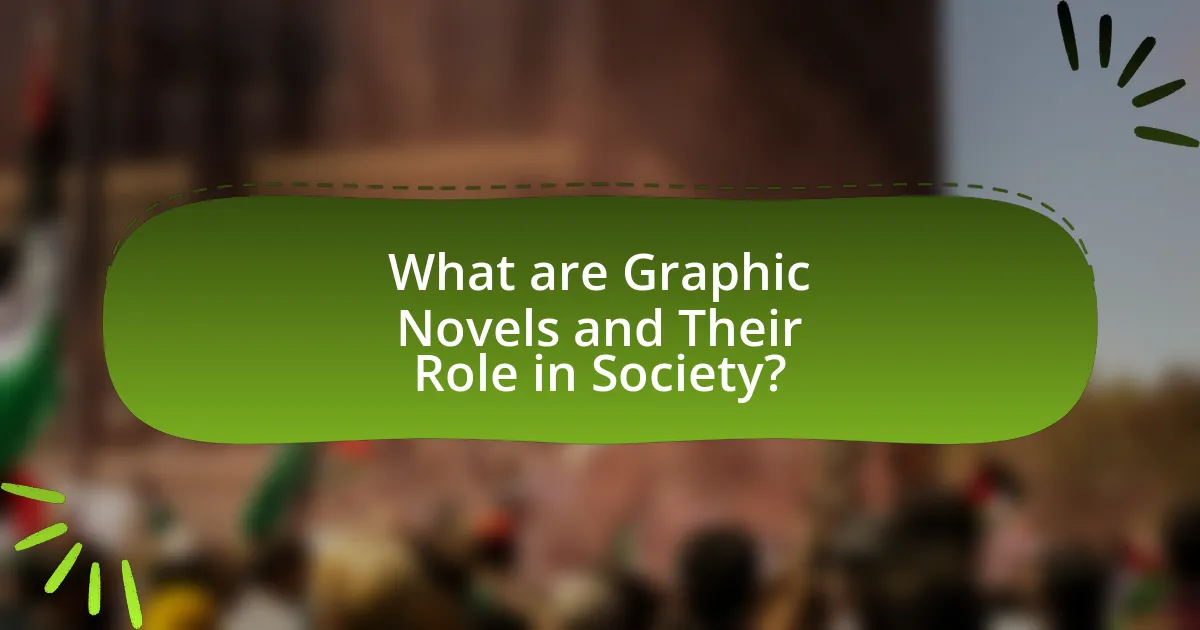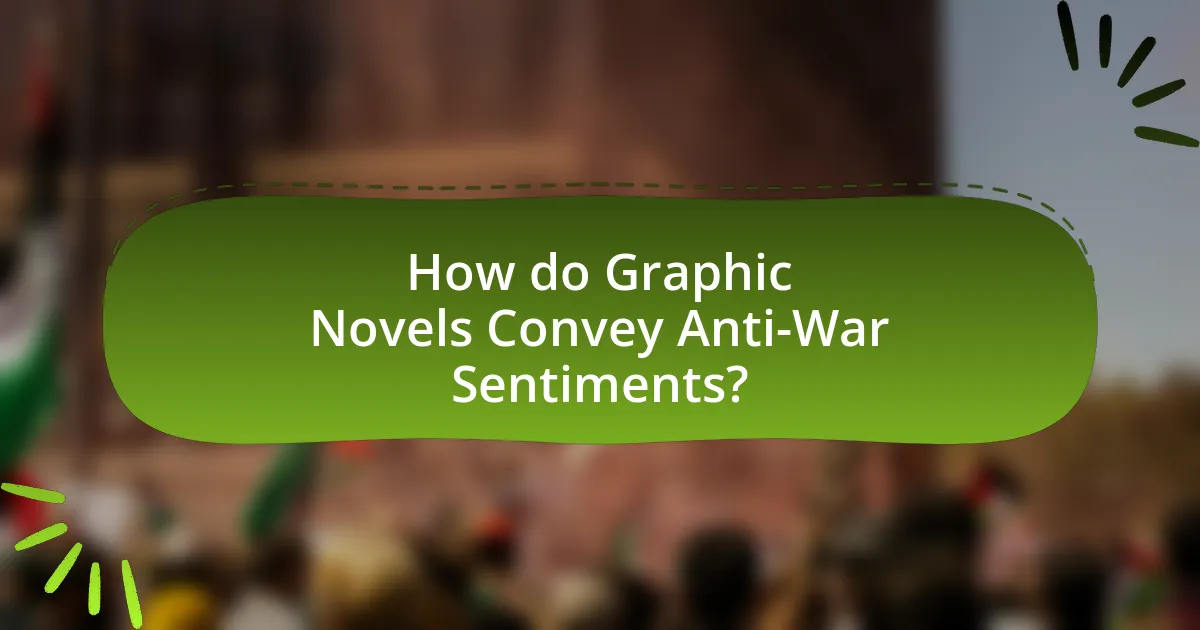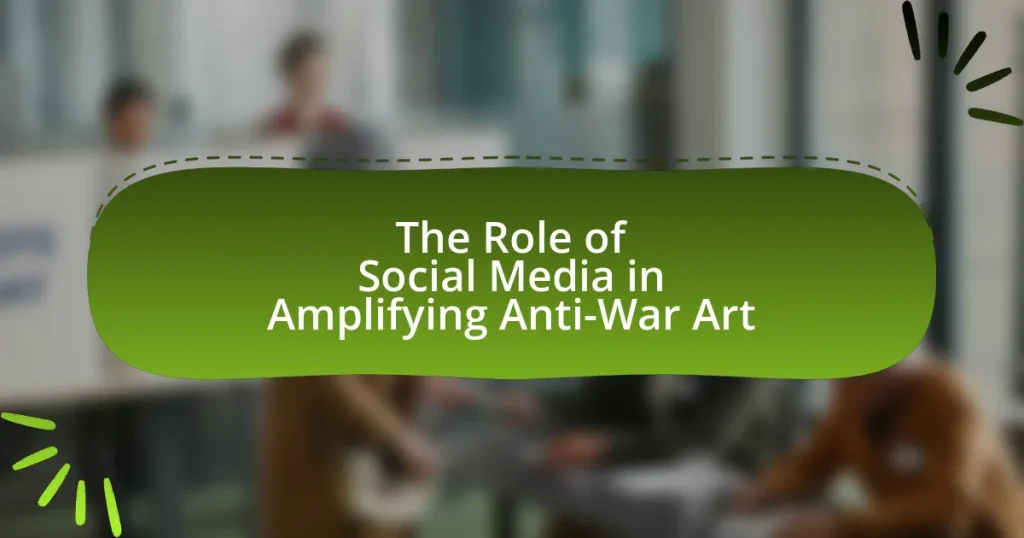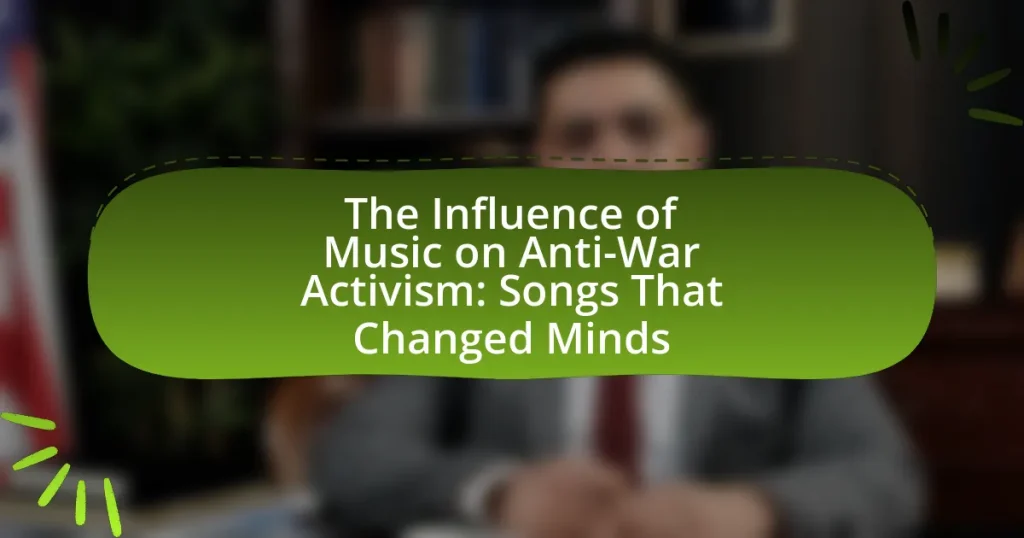Graphic novels are a unique form of visual storytelling that combines illustrations and text to convey narratives, often addressing complex themes and social issues, particularly anti-war sentiments. They serve as powerful tools for fostering empathy, promoting literacy, and providing social commentary, as exemplified by works like “Maus” and “Persepolis.” The article explores how graphic novels differ from traditional literature, the storytelling techniques they employ, and their ability to reflect cultural and political sentiments. It also examines the emotional impact of illustrations, the role of personal narratives, and the challenges faced in promoting anti-war messages through this medium. Additionally, the article discusses the influence of graphic novels on public perception of war and their effectiveness in inspiring activism against conflict.

What are Graphic Novels and Their Role in Society?
Graphic novels are a form of visual storytelling that combines illustrations and text to convey narratives, often addressing complex themes and social issues. Their role in society includes fostering empathy, promoting literacy, and serving as a medium for political and social commentary. For instance, graphic novels like “Maus” by Art Spiegelman and “Persepolis” by Marjane Satrapi have effectively communicated the horrors of war and the impact of conflict on personal lives, thereby influencing public perception and anti-war sentiments. These works demonstrate how graphic novels can engage readers emotionally and intellectually, making them powerful tools for social change and awareness.
How do graphic novels differ from traditional literature?
Graphic novels differ from traditional literature primarily in their use of visual elements to convey narrative. While traditional literature relies solely on text to develop characters and plot, graphic novels combine illustrations with written dialogue and narration, creating a multi-layered storytelling experience. This visual component allows for immediate emotional engagement and can enhance the reader’s understanding of complex themes, such as anti-war sentiments, by depicting scenes and emotions that text alone may struggle to convey. For instance, the graphic novel “Maus” by Art Spiegelman uses stark imagery alongside its narrative to powerfully illustrate the horrors of the Holocaust, demonstrating how graphic novels can uniquely impact readers’ perceptions and feelings about historical events.
What unique storytelling techniques are used in graphic novels?
Graphic novels utilize unique storytelling techniques such as visual narrative integration, non-linear timelines, and the juxtaposition of text and imagery. Visual narrative integration allows readers to experience the story through a combination of illustrations and written dialogue, enhancing emotional engagement. Non-linear timelines enable complex storytelling by presenting events out of chronological order, which can reflect the chaotic nature of war and its impact on individuals. The juxtaposition of text and imagery creates a layered meaning, where visuals can convey emotions and themes that words alone may not fully express, as seen in works like “Maus” by Art Spiegelman, which uses graphic elements to depict the Holocaust’s horrors alongside personal narratives. These techniques collectively enrich the storytelling experience in graphic novels, making them a powerful medium for conveying anti-war sentiments.
How do illustrations enhance the narrative in graphic novels?
Illustrations enhance the narrative in graphic novels by visually conveying emotions, actions, and settings that complement the text. This visual storytelling allows readers to engage more deeply with the characters and plot, as images can evoke immediate emotional responses and provide context that words alone may not fully capture. For instance, in graphic novels like “Maus” by Art Spiegelman, the illustrations of anthropomorphic characters and stark imagery of war amplify the themes of trauma and loss, making the narrative more impactful. The combination of visual elements and textual narrative creates a multi-layered experience that can effectively communicate complex themes, such as anti-war sentiments, by illustrating the harsh realities of conflict and its consequences on individuals and society.
Why are graphic novels considered a powerful medium for social commentary?
Graphic novels are considered a powerful medium for social commentary because they combine visual art and narrative storytelling to engage readers emotionally and intellectually. This unique blend allows complex social issues to be presented in an accessible format, making them relatable and impactful. For instance, graphic novels like “Maus” by Art Spiegelman and “Persepolis” by Marjane Satrapi effectively address themes of war, identity, and oppression, illustrating the human experience behind historical events. The visual elements enhance the narrative, allowing for a deeper understanding of the emotional weight of social issues, which can lead to increased awareness and empathy among readers.
What historical events have been depicted in graphic novels?
Graphic novels have depicted numerous historical events, including the Holocaust, the Vietnam War, and the Civil Rights Movement. For instance, “Maus” by Art Spiegelman illustrates the Holocaust through the experiences of his father, a Polish Jew, showcasing the atrocities faced during World War II. Similarly, “Persepolis” by Marjane Satrapi recounts the Iranian Revolution, providing a personal perspective on the impact of political upheaval. Additionally, “March” by John Lewis chronicles the Civil Rights Movement, highlighting key events such as the Selma to Montgomery marches. These graphic novels serve as powerful mediums for conveying complex historical narratives and fostering anti-war sentiments.
How do graphic novels reflect cultural and political sentiments?
Graphic novels reflect cultural and political sentiments by using visual storytelling to convey complex themes and social issues. For instance, works like “Maus” by Art Spiegelman illustrate the Holocaust’s impact on identity and memory, while “Persepolis” by Marjane Satrapi explores the Iranian Revolution’s effects on personal and national identity. These narratives engage readers emotionally and intellectually, often prompting discussions about war, oppression, and resistance. The combination of imagery and text allows for a nuanced exploration of societal issues, making graphic novels a powerful medium for expressing and critiquing cultural and political sentiments.

How do Graphic Novels Convey Anti-War Sentiments?
Graphic novels convey anti-war sentiments through visual storytelling, character development, and emotional engagement. By depicting the harsh realities of war, such as violence, loss, and trauma, graphic novels like “Maus” by Art Spiegelman and “Persepolis” by Marjane Satrapi illustrate the personal and societal impacts of conflict. These narratives often highlight the futility of war and the suffering it causes, using powerful imagery and dialogue to evoke empathy in readers. For instance, “Maus” portrays the Holocaust’s horrors, emphasizing the human cost of war, while “Persepolis” critiques the Iranian Revolution’s consequences on everyday lives. Such representations effectively challenge glorified notions of warfare and promote anti-war perspectives.
What themes are commonly explored in anti-war graphic novels?
Common themes explored in anti-war graphic novels include the futility of war, the psychological impact on soldiers, the dehumanization of combatants, and the consequences of violence on society. These themes are often illustrated through personal narratives and historical contexts, emphasizing the emotional and moral dilemmas faced by individuals involved in conflict. For instance, works like “Maus” by Art Spiegelman depict the trauma of war and its lasting effects on survivors, while “Persepolis” by Marjane Satrapi highlights the absurdity of war through the lens of a young girl growing up during the Iranian Revolution. Such graphic novels serve to critique militarism and promote peace by showcasing the human cost of warfare.
How do personal narratives shape the anti-war message in graphic novels?
Personal narratives in graphic novels significantly shape the anti-war message by providing intimate, humanized accounts of war experiences. These narratives often depict the emotional and psychological toll of conflict on individuals, making the abstract concept of war more relatable and tangible. For instance, graphic novels like “Maus” by Art Spiegelman and “Persepolis” by Marjane Satrapi illustrate personal stories that highlight the trauma and moral dilemmas faced by those affected by war, effectively conveying the futility and devastation of violence. This personal approach fosters empathy in readers, encouraging them to question the justifications for war and consider its real-life consequences.
What role does symbolism play in conveying anti-war sentiments?
Symbolism plays a crucial role in conveying anti-war sentiments by using visual metaphors and imagery to evoke emotional responses and critique the consequences of war. In graphic novels, symbols such as broken weapons, desolate landscapes, and the juxtaposition of innocence against violence serve to highlight the futility and devastation of conflict. For instance, in Art Spiegelman’s “Maus,” the depiction of Jews as mice and Nazis as cats symbolizes the predator-prey relationship, emphasizing the dehumanization and brutality of war. This use of symbolism effectively communicates the horrors of war, making the anti-war message more impactful and relatable to readers.
How have specific graphic novels influenced public perception of war?
Specific graphic novels have significantly influenced public perception of war by presenting complex narratives that challenge traditional glorifications of conflict. For instance, “Maus” by Art Spiegelman portrays the Holocaust through the lens of a son recounting his father’s experiences, which humanizes the trauma of war and fosters empathy. Similarly, “Persepolis” by Marjane Satrapi illustrates the impact of the Iranian Revolution on personal lives, highlighting the absurdities and horrors of war, thereby encouraging critical reflection among readers. These works, through their unique storytelling and visual artistry, have contributed to a broader understanding of the human cost of war, shifting public sentiment towards a more anti-war perspective.
What are some notable examples of graphic novels with anti-war themes?
Notable examples of graphic novels with anti-war themes include “Maus” by Art Spiegelman, which depicts the Holocaust and its impact on survivors, and “Persepolis” by Marjane Satrapi, illustrating the effects of the Iranian Revolution and the Iran-Iraq War. “The ‘Nam” by Doug Murray and Michael Golden provides a gritty portrayal of the Vietnam War, highlighting its brutal realities. Additionally, “Fun Home” by Alison Bechdel touches on themes of personal conflict against the backdrop of societal issues, including war. These works effectively convey the emotional and psychological toll of war, reinforcing anti-war sentiments through their narratives and artistic expressions.
How do these graphic novels resonate with readers emotionally?
Graphic novels resonate with readers emotionally by depicting complex characters and relatable narratives that evoke empathy and reflection. These stories often explore themes of loss, trauma, and resilience, allowing readers to connect deeply with the experiences portrayed. For instance, graphic novels like “Maus” by Art Spiegelman illustrate the Holocaust’s impact on personal and collective memory, fostering a profound emotional response through its visual storytelling and poignant dialogue. This emotional engagement is further supported by research indicating that visual narratives can enhance emotional understanding and retention, making the themes more impactful for readers.

What Impact Do Graphic Novels Have on Anti-War Movements?
Graphic novels significantly impact anti-war movements by providing a compelling medium for storytelling that conveys the emotional and psychological effects of war. They engage readers through visual narratives, making complex themes more accessible and relatable. For instance, works like “Maus” by Art Spiegelman and “Persepolis” by Marjane Satrapi illustrate the horrors of war and its aftermath, fostering empathy and understanding among audiences. These narratives often highlight the personal experiences of individuals affected by conflict, which can galvanize public sentiment against war. Research indicates that graphic novels can effectively raise awareness and inspire activism, as seen in the increased discussions around war-related issues following the publication of influential titles.
How do graphic novels inspire activism against war?
Graphic novels inspire activism against war by presenting complex narratives that humanize the experiences of individuals affected by conflict. These visual stories often depict the emotional and psychological toll of war, making the consequences more relatable and impactful for readers. For instance, works like “Maus” by Art Spiegelman illustrate the horrors of the Holocaust, prompting readers to reflect on the moral implications of war and genocide. Additionally, graphic novels such as “Persepolis” by Marjane Satrapi provide personal accounts of life during the Iranian Revolution, fostering empathy and understanding that can galvanize readers into action. The combination of visual art and storytelling in graphic novels effectively engages audiences, encouraging them to question the status quo and advocate for peace.
What strategies do graphic novels use to mobilize readers for anti-war causes?
Graphic novels mobilize readers for anti-war causes through visual storytelling, emotional engagement, and historical context. By combining illustrations with narrative, graphic novels create a powerful medium that evokes empathy and personal connection to the experiences of war. For instance, works like “Maus” by Art Spiegelman depict the Holocaust’s horrors, fostering a deep understanding of the consequences of conflict. Additionally, graphic novels often incorporate real-life events and testimonies, such as in “Persepolis” by Marjane Satrapi, which illustrates the impact of the Iranian Revolution, thereby contextualizing the human cost of war. These strategies effectively raise awareness and encourage readers to reflect critically on the implications of military actions.
How have graphic novels been used in educational settings to promote anti-war messages?
Graphic novels have been utilized in educational settings to promote anti-war messages by providing accessible narratives that engage students emotionally and intellectually. These visual stories often depict the human cost of war, illustrating the experiences of soldiers and civilians affected by conflict, which fosters empathy and critical thinking among readers. For instance, works like “Maus” by Art Spiegelman and “Persepolis” by Marjane Satrapi have been integrated into curricula to encourage discussions about the consequences of war and the importance of peace. Research indicates that graphic novels can enhance comprehension and retention of complex themes, making them effective tools for conveying anti-war sentiments in classrooms.
What challenges do graphic novels face in promoting anti-war sentiments?
Graphic novels face significant challenges in promoting anti-war sentiments due to their often niche audience and the potential for misinterpretation of visual narratives. The complexity of conveying nuanced anti-war messages through illustrations can lead to oversimplification, where readers may not grasp the intended critique of war. Additionally, graphic novels may struggle to reach broader audiences compared to traditional literature, limiting their impact. For instance, while works like “Maus” by Art Spiegelman effectively address the horrors of war, they may not resonate with all demographics, particularly those less engaged with the medium. Furthermore, the commercialization of graphic novels can dilute their anti-war messages, as publishers may prioritize marketability over thematic depth. These factors collectively hinder the effectiveness of graphic novels in fostering widespread anti-war sentiments.
How do censorship and political backlash affect the distribution of anti-war graphic novels?
Censorship and political backlash significantly hinder the distribution of anti-war graphic novels by limiting their availability and visibility in the market. When governments or organizations impose restrictions on content deemed politically sensitive, it can lead to the removal of these works from bookstores, libraries, and online platforms. For instance, during the Vietnam War, graphic novels that criticized U.S. involvement faced bans and were often excluded from educational curricula, which directly impacted their readership and distribution channels. Additionally, political backlash can result in self-censorship among publishers and creators, who may avoid producing or distributing anti-war content to evade potential repercussions, further stifling the dissemination of these narratives.
What are the limitations of graphic novels in influencing public opinion on war?
Graphic novels have limitations in influencing public opinion on war primarily due to their niche audience and the complexity of war narratives. The medium often appeals to specific demographics, such as younger readers or graphic novel enthusiasts, which can restrict broader societal impact. Additionally, the nuanced and multifaceted nature of war makes it challenging to convey comprehensive messages within the constraints of a graphic format. For instance, while graphic novels like “Maus” and “Persepolis” effectively address personal experiences of war, they may not encompass the full geopolitical context or diverse perspectives necessary for a well-rounded public opinion. Consequently, the simplification of complex issues into visual storytelling can lead to misinterpretations or oversimplifications, limiting their effectiveness in shaping widespread anti-war sentiments.
What are some best practices for creating impactful anti-war graphic novels?
To create impactful anti-war graphic novels, authors should focus on authentic storytelling, strong character development, and visual symbolism. Authentic storytelling involves presenting real experiences and perspectives from those affected by war, which can evoke empathy and understanding. Strong character development allows readers to connect emotionally with the characters, making the anti-war message more resonant. Visual symbolism, such as using recurring motifs or imagery that represents peace versus conflict, can enhance the narrative and reinforce the themes of the graphic novel. These practices have been effective in works like “Maus” by Art Spiegelman and “Persepolis” by Marjane Satrapi, which successfully convey the horrors of war and its impact on individuals and society.



